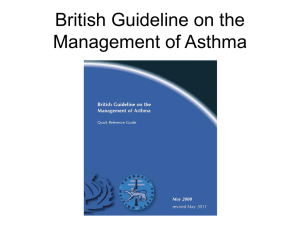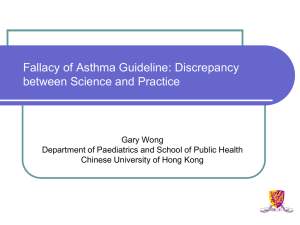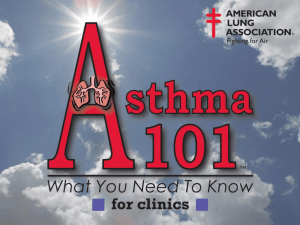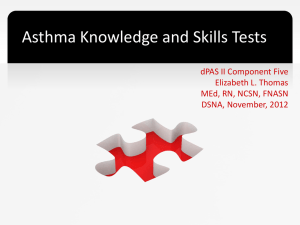Acute Asthma in Adults - Saudi Initiative for Asthma Group (SINA)
advertisement
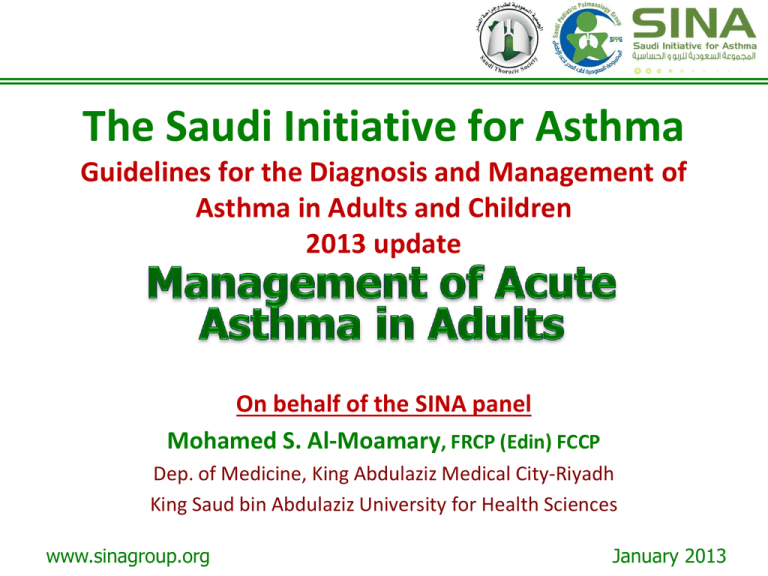
The Saudi Initiative for Asthma Guidelines for the Diagnosis and Management of Asthma in Adults and Children 2013 update On behalf of the SINA panel Mohamed S. Al-Moamary, FRCP (Edin) FCCP Dep. of Medicine, King Abdulaziz Medical City-Riyadh King Saud bin Abdulaziz University for Health Sciences www.sinagroup.org January 2013 Enter presenter name Enter the presenter’s institute www.sinagroup.org January 2013 What is SINA? SINA is developed by a task force originated from the Saudi Initiative for Asthma Group under the umbrella of the Saudi Thoracic Society SINA is a practical approach for a comprehensive management of asthma in adults and children and when to refer to a specialist. International recommendations were customized to the local setting for asthma diagnosis and management Directed to HCW dealing with asthma who are not specialists in the field. www.sinagroup.org January 2013 Purpose of SINA To provide a document that is easy to follow, simple to understand yet totally updated and carefully prepared for use by non-asthma specialist including primary care doctors and general practice physicians www.sinagroup.org January 2013 Where do you find SINA? The SINA guideline was published in the Annals of Thoracic Medicine (www.thoracicmedicine.org): Al-Moamary MS, Alhaider SA, Al-Hajjaj MS, Al-Ghobain MO, Idrees MM, Zeitouni MO, Al-Harbi AS, Al Dabbagh MM, AlMatar H, Alorainy HS. The Saudi initiative for asthma - 2012 update: Guidelines for the diagnosis and management of asthma in adults and children. Ann Thorac Med 2012;7:175204 The SINA guidelines booklet is available at: www.sinagroup.org www.sinagroup.org January 2013 Saudi Thoracic Society commitment The STS is committed to improve the care of asthma by a long term plan: Periodic scientific meetings Annual asthma meeting (since 2001) Frequent asthma courses Educational brochures Publishing new and updated asthma guidelines www.sinagroup.org January 2013 What is new in SINA-2012 Comprehensive revision with the addition of new 125 references Addition of charts and algorithms for asthma diagnosis and management Updating asthma management Rewritten “asthma in children” section New section on “difficult to treat asthma” www.sinagroup.org January 2013 SINA Panel Mohamed S. Al-Moamary (Chairman), King Saud bin Abdulaziz University for Health Sciences, Riyadh Sami Alhaider, King Faisal Specialist Hospital and Research Center, Riyadh Mohamed S. Al-Hajjaj, King Saud University, Riyadh Mohammed O. AlGhobain, King Saud bin Abdulaziz University for Health Sciences, Riyadh Majdy M. Idrees, Military Hospital, Riyadh Mohamed O. Zeitouni, King Faisal Specialist Hospital and Research Center, Riyadh Adel S. Alharbi, Military Hospital, Riyadh Hussain Al-Matar, Imam Abdulrahman Al Faisal, Dammam Maha M. Al Dabbagh, King Fahd Armed Forces Hospital, Jeddah Hassan S Alorainy, King Faisal Specialist Hospital and Research Center, Riyadh www.sinagroup.org January 2013 Acknowledgment • • • • • The SINA panel would like to thank the following reviewers : Prof. J. Mark FitzGerald from the University of British Columbia, Vancouver, BC, Canada Prof. Qutayba Hamid from the Meakins-Christie Laboratories, and the Montreal Chest Research Institute Prof. Sheldon Spier, the University of British Columbia, Vancouver, Canada Prof. Eric Bateman from the University of Cape Town Lung Institute, Cape Town, South Africa (SINA 2009) Prof. Ronald Olivenstein from the Meakins-Christie Laboratories and the Montreal Chest Research Institute, Royal Victoria Hospital, McGill University, Montreal, Quebec, Canada. (SINA 2009) www.sinagroup.org January 2013 SINA Documents Published manuscript Booklet Electronic version Slides kit Flyers Website: www.sinagroup.org www.sinagroup.org January 2013 Sections of SINA – update cover Epidemiology Pathophysiology Diagnosis Medications Approach to Management Treatment Steps Special Situations Acute Asthma www.sinagroup.org January 2013 Prevalence Prevalence of asthma has increased between 1986 – 1995 Alfrayyah et al. Ann Allergy Asthma Immunol 2001;86:292–296 www.sinagroup.org January 2013 Burden of Asthma Asthma is among the most common chronic illnesses in Saudi Arabia 53% had missed school or work (AIRKSA-2007) 35% attempted Unconventional therapy (Al Moamary, ATM 2008) 46% were controlled in Riyadh (AIRKSA-2007) 36% were controlled in 5 tertiary care centers in Riyadh (Aljahdali SMJ-2008) 48% were controlled in one center (Al Moamary, ATM 2008) www.sinagroup.org January 2013 AIRKSA report (Ministry of Health) 78 % of adults & 84% of kids reported acute asthma over 12 months (AIRKSA) 54 % of adults & 80% of kids reported ER over 12 months (AIRKSA) 45-68% of adults & 37-56% of kids reported limitation of activity over 12 months (AIRKSA) 76 % of adults & 78% of kids never had spirometry(AIRKSA) www.sinagroup.org January 2013 The prevalence of wheeze and associated symptoms in the study group Al-Ghobain et al, NBC Pulm Med 2012;12:39 www.sinagroup.org January 2013 Pattern of asthma treatment Al-Shimemeri, Ann Thorac Med 2006;1:20-5 www.sinagroup.org January 2013 Pathology of Asthma Inflammation Airway Hyper-responsiveness Airway Obstruction Symptoms of Asthma www.sinagroup.org January 2013 Pathophysiology www.sinagroup.org January 2013 Inflammation Remodeling Inflammation Airway Hypersecretion Subepithelial fibrosis Angiogenesis www.sinagroup.org January 2013 Diagnosis - History Episodic attacks: Cough Breathlessness Wheezing Nocturnal symptoms Patient could be asymptomatic between attacks co-existent conditions: GERD, rhinosinusitis. www.sinagroup.org January 2013 Relevant Questions Does the patient or his/her family have a history of asthma or other atopic conditions, such as eczema or allergic rhinitis? Does the patient have recurrent attacks of wheezing? Does the patient have a troublesome cough at night? Does the patient wheeze or cough after exercise? Does the patient experience wheezing, chest tightness, or cough after exposure to pollens, dust, feathered or furry animals, exercise, viral infection, or environmental smoke? www.sinagroup.org January 2013 Relevant Questions Does the patient experience worsening of symptoms after taking aspirin/nonsteroidal inflammatory medication or use of B-blockers? Does the patient's cold “go to the chest” or take more than 10 days to clear up? Are symptoms improved by appropriate asthma treatment? Are there any features suggestive of occupational asthma www.sinagroup.org January 2013 Physical Examination Normal between attacks Bilateral expiratory wheezing Examination of the upper airways Other allergic manifestations: e.g., atopic dermatitis/eczema Consider alternative Dx when there is localized wheeze, crackles, stridor, clubbing www.sinagroup.org January 2013 Investigations Measurements of lung function: Spirometry Peak expiratory flow (PEF) Normal Spirometry does not role out asthma Spirometry is superior to PEF www.sinagroup.org January 2013 Bronchodilator response Proper instructions on how to perform the forced expiratory maneuver must be given to patients, and the highest value of three readings taken. The degree of significant reversibility is defined as an improvement in FEV1 ≥12% and ≥200 ml from the pre-bronchodilator value. www.sinagroup.org January 2013 Clinical Assessment Measurements of allergic status to identify risk factors (if indicated) Chest X-ray is not routinely recommended Routine blood tests are not routinely recommended IgE measurement is indicated in severe cases www.sinagroup.org January 2013 Assessment of Asthma Control www.sinagroup.org January 2013 Asthma Control Test Level of Control: • Total: 25 • Control: 20-24 • Partial control: 16-19 • Uncontrolled: www.sinagroup.org < 16 January 2013 Differential Diagnosis Upper airway diseases Allergic rhinitis and sinusitis Obstructions involving large airways Foreign body in trachea or bronchus Vocal cord dysfunction Vascular rings or laryngeal webs Laryngotracheomalacia, tracheal stenosis, or bronchostenosis Enlarged lymph nodes or tumor Obstructions involving small airways Viral bronchiolitis or obliterative bronchiolitis Cystic fibrosis Bronchopulmonary dysplasia Heart disease Other causes Recurrent cough not due to asthma Aspiration from swallowing mechanism dysfunction or GERD www.sinagroup.org January 2013 Management of Acute Asthma www.sinagroup.org January 2013 Acute Asthma in Adults Most patients who present with an acute asthma exacerbation have chronic uncontrolled asthma The following should be carefully checked: previous history of near fatal asthma patient taking three or more medications heavy use of SABA and frequent ER visits Patient should be assessed to determine the severity of acute attacks PEF and pulse oximetry measurements are complementary to history taking and physical examination www.sinagroup.org January 2013 Levels of severity of acute asthma exacerbations in adults www.sinagroup.org January 2013 Initial Assessment of Acute Asthma www.sinagroup.org January 2013 Medications used in acute asthma Oxygen High concentration of inspired oxygen to correct hypoxemia (do not miss COPD) Pulse oximetry should be used to tailor oxygen therapy Failure to achieve oxygen saturations of more than 92% is a good predictor of the need for hospitalization Normal or high PaCO2 is an indication of a severe attack, and need for specialist consultation www.sinagroup.org January 2013 Bronchodilators Inhaled salbutamol is the preferred choice Repeated doses is recommended at 15–30 minute intervals. Alternatively, continuous nebulization (Salbutamol at 5–10 mg/hour) may be used for one hour if there is an inadequate response to initial treatment. www.sinagroup.org January 2013 Bronchodilators Patients who are able to use the inhaler devices, 6–12 puffs of MDI with a spacer are equivalent to 2.5 mg of Salbutamol by nebulizer In moderate to severe acute asthma, combining ipratropium bromide with Salbutamol has some additional bronchodilation effects, in reducing hospitalizations and greater improvement in PEF or FEV1 www.sinagroup.org January 2013 Steroid therapy Systemic steroids: reduce relapses and subsequent hospital admission Oral steroid = injected steroids Oral prednisolone: 40–60 mg daily Systemic steroids should be given for seven days for adults and three to five days for www.sinagroup.org January 2013 Magnesium sulphate A single dose of IV magnesium sulphate (1.2– 2 gm IV infusion over 20 mins) is safe and effective Routine use of IV magnesium sulphate in patients with acute asthma presenting to emergency department is not recommended. Its use should be limited to those with sever exacerbation who fail to respond to treatment after an hour www.sinagroup.org January 2013 Intravenous aminophylline In acute asthma, the use of intravenous aminophylline did not result in any additional bronchodilation compared to standard care with B2-agonists www.sinagroup.org January 2013 Antibiotics Viral infection is the usual cause of asthma exacerbation The role of bacterial infection has been probably overestimated, and routine use of antibiotics is strongly discouraged They should be used when there is associated pneumonia or bacterial bronchitis www.sinagroup.org January 2013 Initial Management of Acute Asthma www.sinagroup.org January 2013 If there is an adequate response www.sinagroup.org January 2013 If there is a partial response www.sinagroup.org January 2013 If there is a poor response www.sinagroup.org January 2013 Referral to a specialist center Status asthmatics Deteriorating PEF Persisting or worsening hypoxia Hypercapnea, respiratory acidosis (pH <7.3) Severe exhaustion Increase work of breathing Drowsiness Confusion Coma Respiratory arrest www.sinagroup.org January 2013 Criteria for admission Patients whose peak flow is ≥ 60% best or predicted one hour after initial treatment can be discharged from the emergency department Criteria for admission: Any feature of a life threatening, near fatal attack Any feature of a severe attack that persists after initial treatment. unless any of the following is present: still suffering from significant symptoms previous history of near fatal or brittle asthma concerns about compliance and pregnancy www.sinagroup.org January 2013 Asthma in children < 5 years No tests can diagnose asthma with certainty. Lung function testing is not very helpful CXR may help to exclude structural abnormalities of the airway. A trial of treatment with short-acting bronchodilators and inhaled corticosteroids (ICS) for at least 8 to 12 weeks may provide some guidance as to the presence of asthma. www.sinagroup.org January 2013 Acute asthma in children < 5 years Immediate medical attention should be taken in case of children less than two year who had a history of poor response to three doses of SABA within 1–2 hours, saturation less than 92%, or the child is acutely distressed. In this age group, the risk of fatigue, respiratory compromise and dehydration is considerable www.sinagroup.org January 2013

